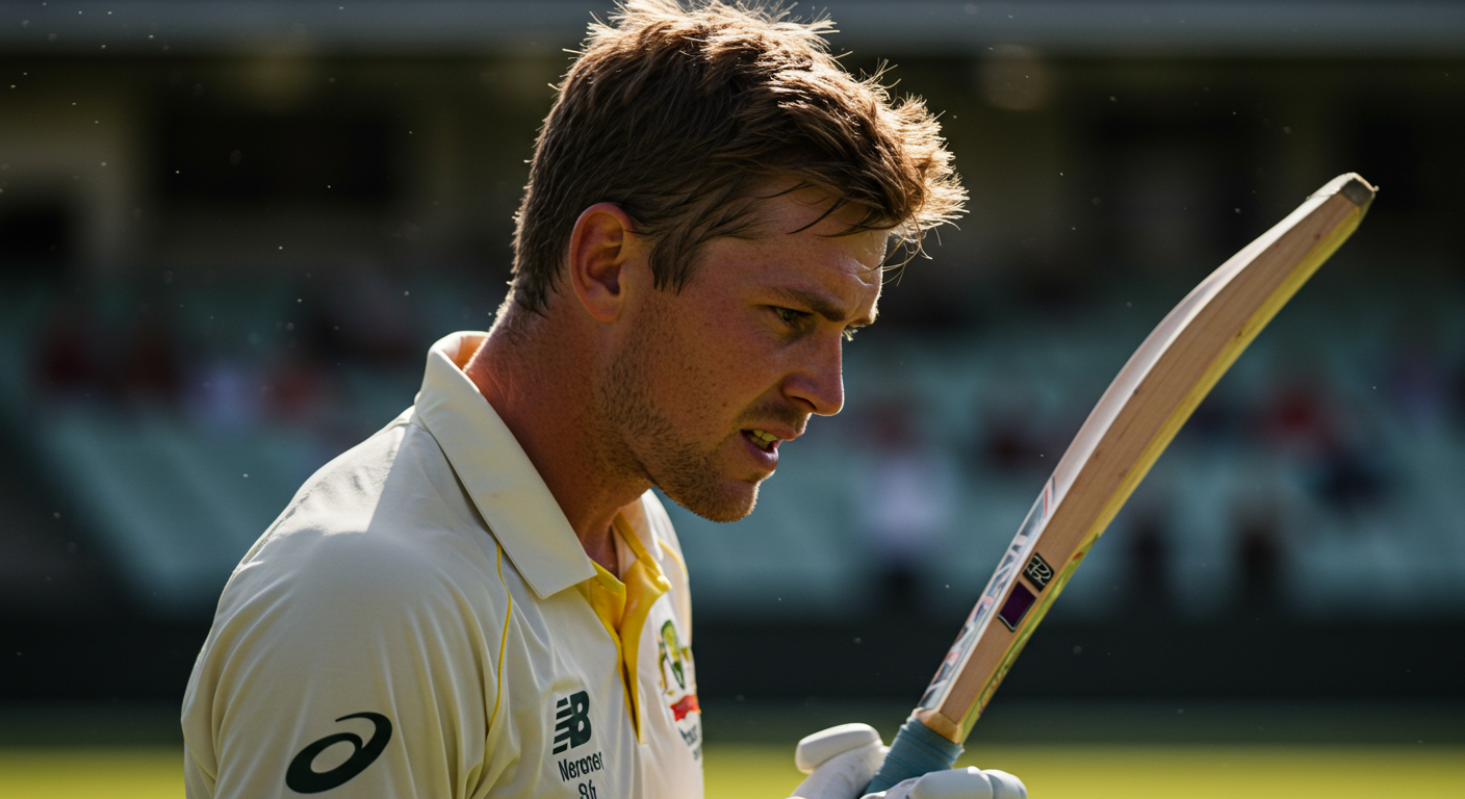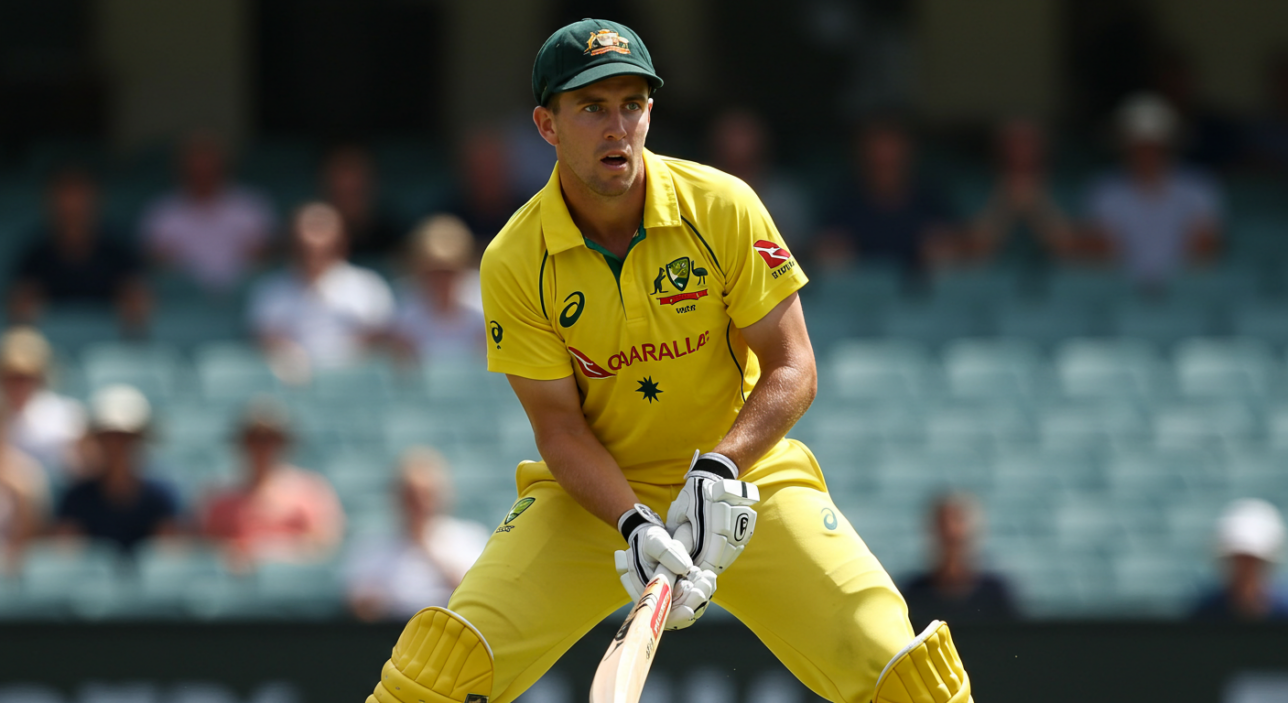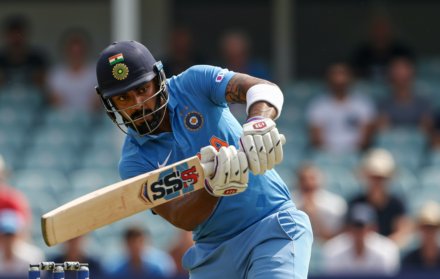
Cameron Green: The Aussie All-Rounder With Giant Potential
In the landscape of modern cricket, few prospects have generated as much intrigue as Cameron Green. Standing at 6’6″, he is not just physically imposing—he is a technical anomaly. Australia’s search for a reliable seam-bowling all-rounder post-Shane Watson had seen several contenders rise and fall, but Green’s combination of raw ability, composure under pressure, and capacity for adaptation has marked him out as something different altogether.
His numbers might not yet scream global superstar, but Green’s presence in all three formats for Australia—particularly in the Test arena—speaks volumes about how highly he is rated by selectors and teammates alike. His early promise was visible during his teenage years in Western Australia, and the way he has navigated injuries, expectations, and the ever-demanding calendar of international cricket suggests a maturity beyond his years.
This article delves into Cameron Green’s journey, analysing his performances, the technical intricacies of his game, and the potential he holds as Australia’s next great all-rounder. Through domestic form, international challenges, and his emergence in the T20 franchise circuit, we examine what makes Green so compelling—and what hurdles he still needs to overcome to fulfil that giant potential.
From Perth Prodigy to National Selectee

Cameron Green’s cricketing roots lie deep in the fast-bouncy tracks of Western Australia. Born in 1999, Green began turning heads at the junior level almost immediately, not just for his height but for his precise control and athleticism with the ball. Originally seen more as a bowling prodigy, it was his five-wicket haul on Sheffield Shield debut at just 17 that lit up headlines. At that point, his batting was still a work in progress, even though he had shown some promise as a lower-order hitter.
Yet a stress fracture in his back soon changed everything. Medical advice urged him to curb his workload with the ball, which in turn gave him more time in the nets to develop his batting. What followed was a stunning transformation: Green not only developed into a competent batsman, he began scoring big. In the 2019–20 Sheffield Shield season, he plundered two double hundreds, including an innings of 251* against Queensland. Suddenly, Australia had a genuine batting all-rounder in the making.
This evolution wasn’t accidental. Green’s work ethic is frequently lauded by coaches and teammates, who describe him as meticulous and methodical. His tall frame allows him to dominate short-pitched bowling, but he’s equally comfortable grinding out innings—something rare for a player of his generation. It didn’t take long for selectors to take notice. In December 2020, he was handed a Test debut against India at Adelaide, marking a rapid rise from domestic wonder to international investment.
Despite a quiet debut series with the bat, his temperament was evident. Green batted patiently against world-class attacks and showed an ability to soak up pressure without letting his technique unravel. With the ball, he offered Australia a steady fourth seamer option, though understandably, they managed his overs carefully. The important takeaway wasn’t immediate results—it was that he belonged at that level, and the investment would likely pay dividends down the line.
Growing into the Test Arena
Cameron Green’s early Test career has been defined not by fireworks, but by steady, incremental growth—exactly the kind of progress that long-format cricket demands. In an era of aggressive stroke play and short-format conversions, Green’s more classical style stands out. With a high elbow, solid defence, and the ability to leave well outside off stump, his batting technique is reminiscent of more traditional Test players.
Yet, that doesn’t mean he’s passive. Against India and England, Green has shown he can shift gears when needed. His maiden Test fifty came under pressure at the SCG in 2021, during a gritty fourth innings pursuit. He wasn’t flamboyant, but he was effective—soaking up 161 deliveries and forming the backbone of a resistance effort. That knock, while not headline-grabbing, sent a clear message: Green could play long, tough innings when the situation demanded.
More recently, he has begun converting starts into meaningful contributions. His century against India in Ahmedabad in 2023—his maiden Test ton—was not just significant statistically. It was a well-constructed innings that blended patience with calculated aggression. Facing spinners on a flat pitch, he used his long reach to nullify turn and picked off runs with composure. It showcased his development—not only in skill, but in match awareness and psychological readiness.
With the ball, he remains a valuable asset. His ability to hit the deck hard and bowl consistent lines at 135–140kph makes him ideal for Australian conditions, where seam and bounce can be lethal weapons. While he doesn’t yet have a standout five-for to his name, his breakthroughs often come at crucial moments—the kind of overs that turn sessions, if not matches.
Green’s Test role is now clearly defined: a dependable No. 6 who can contribute with both bat and ball, while growing into a leadership figure over time. What makes him particularly valuable is that he doesn’t need to be spectacular to be effective—his solidity and adaptability make him one of the most bankable long-term prospects in the format.
Navigating the Demands of White-Ball Cricket

If Test cricket has been about patience and progression for Cameron Green, white-ball formats have demanded a completely different side of his game—power, versatility, and speed. Initially seen as more suited to the red-ball game, Green has undergone a noticeable transformation in T20 and ODI cricket, carving out a place for himself not just in Australia’s squads, but in global franchise leagues as well.
His breakout white-ball moment came during the 2022 tour of India, where, in the absence of key senior players, Green was promoted to open the batting. What followed was a revelation. He blasted 61 off 30 balls in the first match and followed it up with another rapid fifty in the decider. Those innings silenced critics who had questioned his ability to adapt to the shorter format. More importantly, they unlocked a new blueprint for his use—one where his long levers and clean striking could be unleashed at the top of the order.
Green’s bowling in limited-overs cricket has also evolved. He’s often used in short bursts, either with the new ball to exploit bounce or in the middle overs to break partnerships. While not yet a death-overs specialist, his ability to keep things tight and deliver the occasional wicket makes him a useful fifth or sixth bowling option in white-ball sides.
Franchise interest was inevitable. At the 2023 IPL auction, Mumbai Indians snapped him up for a staggering ₹17.5 crore (approx. £1.75m), making him one of the most expensive overseas buys in the tournament’s history. It was a bold call, but one that underscored how highly he is regarded for his future value rather than just current form.
His debut IPL season was a mixed bag—moments of brilliance, including a crucial unbeaten century against Sunrisers Hyderabad, were interspersed with quieter outings. But the takeaway was clear: Green is more than just a Test player. He’s now in the thick of white-ball strategy, both for Australia and for the world’s biggest franchises.
Technical Breakdown: Strengths and Growing Edges
Cameron Green’s technical game is a fascinating study in contrasts. With bat in hand, he exudes a calm, almost old-school presence at the crease—there’s no frenzied footwork or reckless shot selection. Instead, Green relies on his compact technique, strong base, and quick hands, especially against pace. His height allows him to play the short ball with ease, often riding bounce that troubles most top-order batters.
A key strength is his ability to hit down the ground without over-committing. He’s at his best when driving through the V or flicking off his pads—his long reach giving him access to deliveries others might struggle to control. When set, Green can be devastating, particularly in white-ball cricket where he clears boundaries with effortless lofted drives.
But he’s not without flaws. One of the main critiques levelled at him early on was his struggle against quality spin, especially in subcontinental conditions. His front foot sometimes plants too early, and while his reach helps him cover spin, it can also lead to overextension. That said, his maiden Test century in India showed improvement in this area. By picking length early and using soft hands, he managed to defuse turn and play late, rather than committing on instinct.
Bowling-wise, Green is fundamentally sound. His high release point and natural bounce are his biggest weapons, especially on pitches with some life. However, he can occasionally lack penetration on flat decks, where his length becomes predictable. His action is repeatable and easy on the body, which bodes well for long-term fitness, though Australia continues to manage his workload conservatively due to his past back issues.
Ultimately, Green’s game is still evolving. What’s exciting is how rapidly he’s been ironing out his weaknesses—a sign not just of talent, but of a high cricketing IQ and strong coaching support behind the scenes.
Mental Fortitude and Temperament

One of the most impressive aspects of Cameron Green’s rise has been his mental approach to the game. For someone thrust into the national spotlight so young, his temperament is remarkably even-keeled. Rarely flustered, he carries himself with quiet assurance—a calmness that coaches rave about and captains value deeply.
Green’s early career has not been without pressure. From the moment he was dubbed Australia’s next great all-rounder, expectations followed every innings, every spell, every price tag. But unlike others who’ve been burdened by the “next big thing” label, Green appears to embrace the process rather than chase results. Even during lean runs—such as his early white-ball performances or quieter Test series—he has never looked out of place, mentally or emotionally.
That mental strength was on full display during the 2023 Ashes, where Green found himself under scrutiny after a slow start to the series. Rather than retreating, he responded with discipline and control—working through technical tweaks while staying composed in high-pressure moments. Teammates often describe him as one of the most grounded figures in the dressing room, someone who listens more than he speaks, and keeps his internal barometer steady regardless of the match situation.
Part of this temperament stems from his background. Coming from a sporting family in Perth and having navigated injury setbacks early in his career, Green developed resilience before his international debut. He’s also benefited from the guidance of senior pros like Pat Cummins and Steve Smith, who have mentored him through transitions between formats and roles.
Mental toughness, particularly in a volatile era of cricket, is arguably just as vital as skill. In that regard, Green is not just surviving—he’s thriving.
The Franchise Factor: IPL, BBL and Global Ambitions
For a player whose game was forged in the long-format crucible of Sheffield Shield cricket, Cameron Green’s foray into franchise leagues has been both a commercial and tactical evolution. The decision to embrace tournaments like the IPL wasn’t merely about financial reward—it was about pressure. Facing world-class bowlers in high-stakes, high-noise environments has rapidly developed Green’s tactical instincts, shot selection, and tempo control.
His 2023 IPL campaign with Mumbai Indians highlighted both potential and rawness. Batting in various positions, he showed flashes of dominance—his 100* off 47 balls against Sunrisers Hyderabad was a masterclass in timing and composure under playoff pressure. Yet, consistency eluded him at times, a reminder that even elite talents take time to fully adapt to the format’s volatility.
What sets Green apart in franchise cricket is his three-dimensional value. He offers batting power, a solid seam option, and exceptional fielding, especially in the slips and outfield. That versatility makes him a top-tier asset in T20 squads around the world. He’s already a regular fixture in Australia’s white-ball plans and, as his game matures, he’s likely to become one of the few players who can float roles seamlessly between formats and leagues.
Back home, he remains a drawcard in the Big Bash League, although Cricket Australia’s central contracts often restrict his appearances. The balancing act between international duty and franchise opportunities is delicate, but for Green, it’s proving mutually beneficial—each sphere feeding into the other, sharpening both his skill set and global stature.
Franchise cricket, while not the defining feature of his career, has accelerated Green’s development, offering experience that even 50-over internationals can’t replicate. In a cricket economy now driven by multi-format fluency, he is positioning himself not just as an Australian all-rounder, but as a global cricketing commodity.
The Road Ahead: Expectations vs Longevity

Cameron Green’s story is still being written, but the expectations surrounding him are already immense. That in itself is a challenge. Australia hasn’t had a settled seam-bowling all-rounder since Shane Watson, and Green’s emergence has invited inevitable comparisons. But the two are very different players. While Watson was a white-ball powerhouse with bursts of Test success, Green appears to be charting a more balanced, long-format-centric path—with flashes of short-format brilliance.
What’s clear is that Australia sees him as a central figure in its cricketing future. He’s already part of strategic planning across the next two World Test Championship cycles and is a contender for leadership roles down the line. His presence in all formats is being managed carefully, with selectors and medical staff hyper-aware of his injury history and the need to avoid burnout.
That careful stewardship is essential, because Green’s value lies not just in what he does now—but in what he could become over the next decade. Whether it’s averaging 40+ with the bat in Tests, becoming a reliable finisher in ODIs, or delivering game-changing spells in T20s, he has the tools. The real test will be sustaining that performance while managing form, fitness, and the glare of modern cricket’s relentless spotlight.
Longevity in all three formats is rare. But Green has the build, mindset, and technique to make it happen. If he continues on this path, he could redefine what an Australian all-rounder looks like in the 2020s—less bluster, more balance; less hype, more substance.
Conclusion: Australia’s Next Great Investment

Cameron Green may not yet have the statistics of a superstar, but he has something far more valuable: trust. From selectors. From teammates. From fans who see in him a blueprint for the next phase of Australian cricket—grounded, versatile, and quietly effective.
He’s not the finished article, nor does he pretend to be. And that’s perhaps his greatest strength. Green is evolving in real time, balancing workloads, formats, and roles with a humility rare in elite sport. He doesn’t dominate the headlines every week, but when he does, it’s meaningful—a spell that breaks a stubborn partnership, a knock that anchors a crumbling innings, or a performance that sparks belief.
The road ahead will be littered with tests: spin in the subcontinent, franchise burnout, workload stress, and the weight of expectation. But Green has already shown a capacity to handle those variables with poise. If his development continues at this trajectory, we may look back and realise that Cameron Green wasn’t just a promising all-rounder—he was the backbone of a new Australian era.
He is, quite simply, a giant in the making.





